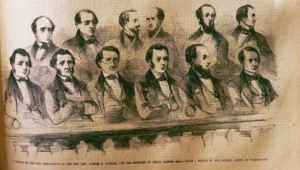After the War
Like most veterans at the conclusion of the Civil War, Sickles’ primary concern was
just getting on with his life. Much of the late 1860s was spent on Reconstruction Duty.
Meanwhile, his wife, Teresa, died unexpectedly in 1867.
Ever the political schmoozer, Sickles managed to secure an appointment from
President Grant as Minister to Spain in 1869 after the Senate tabled the appointment
of Henry Shelton Sanford. In Spain, Sickles soon gained notoriety for his
lavish style of entertaining. Soon, it
was also rumored – and reported in the French Press – that Dan had begun a
romantic affair in Paris with the deposed Spanish Queen, Isabella II.
Following a disagreement with the Secretary of State in late 1873, Sickles resigned his
post in Spain and moved to Paris for a few years. In late 1879, he decided to return to the United States.
As with so many events in his life, Sickles timing for a return to America was very fortuitous. Many veterans of the War Between the States were now ready to commemorate the conflict and Sickles threw himself fully into the cause of veteran’s affairs. His popularity continued to rise as he defended his Gettysburg decision. In 1886 he was appointed chairman of the New York Monuments Commission for the Battle of Gettysburg. This meant securing and placing monuments for all New York divisions and commanders who were present at the battle. Of course, each placement and commemoration afforded another opportunity for Sickles to speak to enthusiastic crowds.
In 1909 Sickles became the last surviving corps commander of either army at the
battle of Gettysburg. He relished the attention and enjoyed his celebrity status.
When Daniel Sickles arrived at the fiftieth Gettysburg anniversary in 1913, he was confined to a wheelchair and unable to make extended speeches, however; he was still afforded celebrity status and newspapers updated readers regularly on his movements and activities.
Eight months after the commemoration of Gettysburg, Daniel Sickles suffered a cerebral hemorrhage and lapsed into semi-consciousness. He died on May 3rd 1914.
The journey of Daniel Sickles is one of a villain, a hero, a soldier, a public servant, a philandering family man, a celebrity, and a flawed human being.









